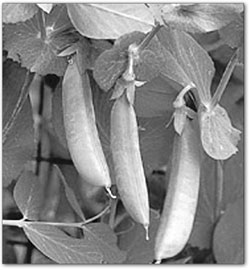|
| ||
| Pea-season picks by Chef Boy Ari Mud Season is here, filling the air with the dreamy odor of its namesake. For housekeepers, it’s time to enforce that “no-shoe” rule – especially upon gardeners so intoxicated by the smell of melting earth that they might overlook their filthy feet as they dash in and out of the house an inordinate number of times. This manic excitement is not without good reason. Many seeds, including spinach, cilantro and sunflowers, can be sown as soon as the ground can be worked, aka: NOW! And for the seeds you want to sow in late April, not to mention the transplants you want to put out in May, now’s a great time to prepare the ground. There is nothing like a seed. With the potential of an entire organism contained within its tiny package, seeds are rightly the stuff of wonderment. But even the seemingly innocent act of planting seeds has joined the world multi-national corporate boycotts, most notably with last year’s purchase of Seminis seeds, the world’s largest vegetable seed company, by the agribusiness giant Monsanto. With this news, many organic growers found themselves in a dilemma pitting deeply held beliefs against each other. On one hand, you have objections to Monsanto’s pro-genetic engineering, pro-chemical farming paradigm that begin to resemble spiritual fervor in their intensity. Now, many of the non-GMO seed varieties popular with the organic crowd are available only from Monsanto. Many growers would like to switch, but it’s difficult to drop a variety that has proven itself year after year. Corporate preferences – Monsanto vs. Seminis – are rather abstract compared to the varying characteristics contained within different types of seed. Fedco Seed Co. asked its customers if they wanted Fedco to market seeds that are now owned by Monsanto, and the response was a resounding “no.” While this move may earn Fedco the loyalty of its core constituency, some farmers will likely continue to acquire their seeds of choice from a corporation they despise. I recently asked farmer Josh Slotnick if he would switch from his beloved (and now Monsanto-owned) sugarsnap pea to a different variety. He looked at me blankly. “Sugarsnap is the only pea to grow,” he said. “It’s the Cadillac of peas.”
Rarely have I noticed a seed variety with so devoted a following as the sugarsnap pea. Ommas Aarden, a seed-saving organization whose name means “Grandmother’s Earth” in Dutch (http://www.om mas-aarden.net/heirloom.htm), calls sugarsnap “the best pea on the planet,” and includes it on a list of “seed saving crops for beginners.” Fedco Seeds, which will no longer carry sugarsnaps after this year, calls it “one of the very best raw treats in the garden.” I also noticed, in my online searches, a farm/restaurant collaboration in Burlington, Vt., named Sugarsnap. This is testament to the popularity of this pea, and I wouldn’t be surprised to learn that there are little two-legged whippersnappers named Sugarsnap running around the farms of America. No other seed variety so epitomizes the dilemma that Monsanto-phobes now face when planning their gardens. I got a call the other night from a jubilant Slotnick, who had decided to get around this dilemma by saving his pea seeds himself. “Sugarsnap peas are self-pollinating,” he said, which means you can easily save your own seeds and plant them next year. “I’m going to plant an extra row, just for seed.” Intrigued by the story of this pea, and hoping for more sugarsnap superlatives to flesh out the reputation of this legendary legume, I called another farmer, Steve Elliott, and asked for his input. “Shell the damn pea!” he barked. “The sugarsnap is a lazy man’s pea. They’re great if you’re just walking by in the garden because you can grab one and put it in your mouth. But if you want a real pea, you need a shelling pea, like Maestro or Green Arrow. Creamed new potatoes with real peas? C’mon, that’s real eatin’.” All shell and snap peas can self-pollinate. They can also cross-pollinate, likely resulting in undesirable hybrid plants next year. So as long as there are no different pea varieties in bloom in the vicinity of your pea plants, saving your peas will give you pure seed. The above-mentioned Maestro and Green Arrow shell peas bloom a few weeks apart, so you could grow both of those in your garden and save them without accidentally making hybrid seeds. Johnny’s (johnnyseeds.com), Fedco (fedcoseeds.com), Seeds Trust (seedstrust.com) and Eden Seeds (edenseeds.com) all carry many snap and shell peas. Pay attention to the trellising needs of each variety. Sugarsnap plants, for example, can grow over 6 feet tall and need major support. Peas are best sown after the spring rains, ideally by the end of April, but you could plant them today. Slotnick says he likes to wait for consistently warmer temperatures. Pattie Fialcowitz, a farmer who loves all kinds of peas equally – including sweet peas – likes to “toss” a handful in the ground now. When they start to grow, she deems the ground ready and plants the rest of her crop. While they’re growing, she eats pea greens in salads and stir-fries. •
|


